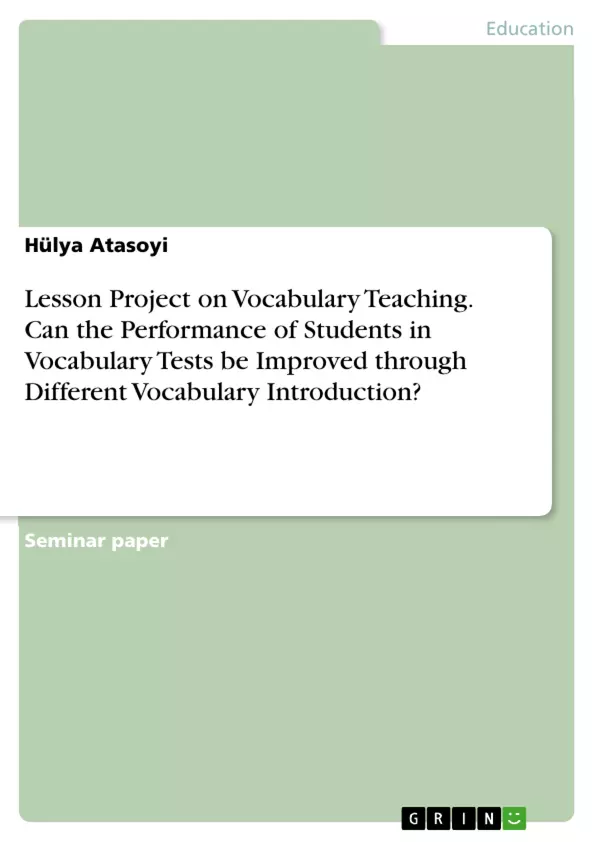Around 30 years ago, vocabulary was considered “a neglected feature of second language research” (Nation 2012: 93). Recent research, however, indicates an “enormous growth in research on vocabulary” (ebd.). Vocabulary is essential to communicate effectively. Nowadays, teachers often test their students’ language skills in vocabulary tests, in which the students have to fill in the correct English translation for the German word. Therefore, many students learn vocabulary through direct translation and without any comprehensible context, but is this kind of learning appropriate?
From my point of view “vocabulary learning is a continual process of encountering new words in meaningful and comprehensible context” (Harmon et al. 2009, cit. in: Bintz 2011: 45). Even if students are performing well in vocabulary tests, it does not mean that they can apply the words in context. Therefore, my lesson project will deal with the following question: Can the performance of students in vocabulary tests be improved through different vocabulary introduction? While focusing on different vocabulary introduction, I will also consider a meaningful and comprehensible context, so that students will be able to apply the words, which they have learned, in new context.
First of all, some theoretical positions and beliefs of vocabulary teaching will be depicted, especially the “main jobs of the vocabulary teacher” (Nation 2012: 93) will be discussed. Various methods of the vocabulary introduction, e.g. creating a board game, word cards, etc. will be described. Students’ performance on vocabulary will be tested by various vocabulary tests with meaningful context. Additionally, the aims as well as the survey instruments and methods of the lesson project will be given. Furthermore, anticipated challenges and possible solutions will be described at the end of Part A (Research and Theories).
After having presented the theoretical background of the lesson project, this paper will have a specific look at the Action Research (Part B of the lesson project) in order to establish a connection between the theoretical context and the practical application. Therefore, based on the lesson project at the Geschwister-Scholl-Gesamtschule in Moers (8th grade), a survey will be conducted at the end of the lesson project, which is also described in chapter 4. The implementation of the lesson project, its results and a discussion will be given in
Part B.
Inhaltsverzeichnis (Table of Contents)
- Portfolio Part A
- Exposé
- 1. Introduction
- 2. Theoretical Background of the Lesson Project
- 3. Aims
- 4. Survey Instruments and Methods
- 5. Anticipated Challenges and Possible Solutions
- Assignment (Reflections on Classroom Discourse)
- 6. Which New Points did I Learn in this Seminar?
- Portfolio Part B
- 7. Lesson Project: Implementation
- 8. Lesson Project: Results
- 9. Lesson Project: Discussion
- 10. References
- 11. List of Figures
- Appendix
Zielsetzung und Themenschwerpunkte (Objectives and Key Themes)
The lesson project aims to explore whether the performance of students in vocabulary tests can be improved through different vocabulary introduction methods. The project investigates the significance of vocabulary learning in a meaningful and comprehensible context, allowing students to apply the learned words in new contexts.
- Impact of vocabulary introduction methods on student performance
- Importance of meaningful and comprehensible context in vocabulary learning
- Effective strategies for vocabulary teaching and learning
- Analyzing the role of vocabulary acquisition in language proficiency
- Implementing a balanced vocabulary course for diverse learners
Zusammenfassung der Kapitel (Chapter Summaries)
- Chapter 1 (Introduction): This chapter introduces the research question, highlighting the importance of vocabulary learning in second language acquisition and the growing body of research on the topic. The project emphasizes the need to move beyond rote memorization and focus on meaningful vocabulary acquisition within context.
- Chapter 2 (Theoretical Background of the Lesson Project): This chapter delves into theoretical frameworks of vocabulary teaching and learning. It discusses key aspects such as the importance of a large vocabulary, the absence of a single 'best' method, and the various factors that influence the selection of teaching methods. The chapter further highlights the significance of "main jobs of the vocabulary teacher," including planning a well-balanced course, training learners in useful strategies, testing vocabulary, and teaching vocabulary.
- Chapter 7 (Lesson Project: Implementation): This chapter describes the practical implementation of the lesson project, including the specific vocabulary introduction methods used and the learning activities designed to promote vocabulary acquisition. The chapter details the classroom activities and the strategies employed to ensure meaningful and comprehensible learning.
- Chapter 8 (Lesson Project: Results): This chapter presents the findings of the lesson project, focusing on the students' performance in vocabulary tests before and after the intervention. The chapter analyzes the data collected to determine the effectiveness of the different vocabulary introduction methods used.
Schlüsselwörter (Keywords)
The main keywords and focus topics of this research project include vocabulary acquisition, second language learning, vocabulary teaching methods, contextualized learning, vocabulary testing, student performance, and classroom practice. The research focuses on exploring the relationship between different vocabulary introduction methods, meaningful learning experiences, and the improvement of students' vocabulary knowledge.
- Quote paper
- Hülya Atasoyi (Author), 2015, Lesson Project on Vocabulary Teaching. Can the Performance of Students in Vocabulary Tests be Improved through Different Vocabulary Introduction?, Munich, GRIN Verlag, https://www.grin.com/document/338205



